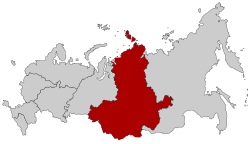This article needs additional citations for verification. (July 2012) |
Siberian Federal District
Сибирский федеральный округ | |
|---|---|
 Location of the Siberian Federal District | |
| Country | |
| Established | 13 May 2000 |
| Administrative centre | Novosibirsk |
| Government | |
| • Presidential Envoy | Anatoly Seryshev |
| Area | |
• Total | 4,361,800 km2 (1,684,100 sq mi) |
| • Rank | 2nd |
| Population (2010) | |
• Total | 17,178,298[2] |
| • Rank | 3rd |
| • Density | 3.8/km2 (10/sq mi) |
| GDP | |
| • Total | ₽ 13.054 trillion US$ 187 billion (2022) |
| • Per capita | ₽ 781,580 US$ 11,182 (2022) |
| Time zones | |
| Omsk Oblast | UTC+06:00 (Omsk Time) |
| most of the district | UTC+07:00 (Krasnoyarsk Time) |
| Irkutsk Oblast | UTC+08:00 (Irkutsk Time) |
| Federal subjects | 10 contained |
| Economic regions | 2 contained |
| HDI (2022) | 0.768[4] high · 6th |
| Website | SFO.gov.ru |
=  | |
Siberian Federal District (Russian: Сибирский федеральный округ, IPA: [sʲɪˈbʲirskʲɪj fʲɪdʲɪˈralʲnɨj ˈokrʊk]) is one of the eight federal districts of Russia. Its population was 17,178,298 according to the 2010 Census,[2] living in an area of 4,361,800 square kilometers (1,684,100 sq mi).[1] The entire federal district lies within the continent of Asia.

The district was created by presidential decree on 13 May 2000[5] and covers around 30% of the total land area of Russia.[6] In November 2018, Buryatia and Zabaykalsky Krai were removed from the Siberian Federal District and added to the Far Eastern Federal District in accordance with a decree issued by Russian President Vladimir Putin.[7]
- ^ a b "1.1. ОСНОВНЫЕ СОЦИАЛЬНО-ЭКОНОМИЧЕСКИЕ ПОКАЗАТЕЛИ в 2014 г." [MAIN SOCIOECONOMIC INDICATORS 2014]. Regions of Russia. Socioeconomic indicators - 2015 (in Russian). Russian Federal State Statistics Service. Retrieved July 26, 2016.
- ^ a b Russian Federal State Statistics Service (2011). Всероссийская перепись населения 2010 года. Том 1 [2010 All-Russian Population Census, vol. 1]. Всероссийская перепись населения 2010 года [2010 All-Russia Population Census] (in Russian). Federal State Statistics Service.
- ^ Валовой региональный продукт по субъектам Российской Федерации в 2016-2022 гг., rosstat.gov.ru
- ^ "Sub-national HDI - Area Database - Global Data Lab". hdi.globaldatalab.org. Retrieved July 20, 2021.
- ^ Putin, V. (May 13, 2000). "Указ Президента Российской Федерации о полномочном представителе Президента Российской Федерации в федеральном округе" [Decree of the President of the Russian Federation on the Plenipotentiary Representative of the President of the Russian Federation in the Federal District] (in Russian). Retrieved June 27, 2024 – via Wikisource.
- ^ "Siberia Federal District, Russia (Siberian)". RussiaTrek.org. Retrieved July 15, 2012.
- ^ "Официальный интернет-портал правовой информации". publication.pravo.gov.ru. Retrieved November 4, 2018.

